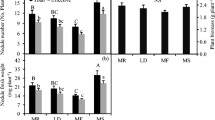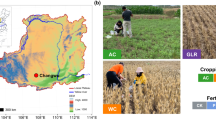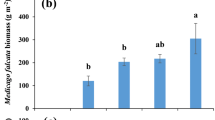Abstract
Plant–soil interactions are known to influence a wide range of ecosystem-level functions. Moreover, the recovery of these functions is of importance for the successful restoration of soils that have been degraded through intensive and/or inappropriate land use. Here, we assessed the effect of planting treatments commonly used to accelerate rates of grassland restoration, namely introduction of different legume species Medicago sativa, Astragalus adsurgens, Melilotus suaveolens, on the recovery of soil microbial communities and carbon and nitrogen contents in abandoned fields of the Loess Plateau, China. The results showed effects were species-specific, and either positive, neutral or negative depending on the measure and time-scale. All legumes increased basal respiration and metabolic quotient and had a positive effect on activity and functional diversity of the soil microbial community, measured using Biolog EcoPlate. However, soil under Astragalus adsurgens had the highest activity and functional diversity relative to the other treatments. Soil carbon and nitrogen content and microbial biomass were effectively restored in 3–5 years by introducing Medicago sativa and Astragalus adsurgens into early abandoned fields. Soil carbon and nitrogen content were retarded in 3–5 years and microbial biomass was retarded in the fifth year by introducing Melilotus suaveolens. Overall, the restoration practices of planting legumes can significantly affect soil carbon and nitrogen contents, and the biomass, activity, and functional diversity of soil microbial community. Therefore, we propose certain legume species could be used to accelerate ecological restoration of degraded soils, hence assist in the protection and preservation of the environment.





Similar content being viewed by others
References
Anderson TH, Domsch KH (1990) Application of ecophysiological quotients (qCO2 and qD) on microbial biomass from soils of different cropping histories. Soil Biol Biochem 22:251–255
Anderson TH, Domsch KH (2010) Soil microbial biomass: the eco-physiological approach. Soil Biol Biochem 42:2039–2043
Bååth E (1998) Growth rates of bacterial communities in soils at varying pH: a comparison of the thymidine and leucine incorporation techniques. Microbial Ecology 36:316–327
Bardgett RD (2005) The biology of soil: a community and ecosystem approach. Oxford University Press, Oxford
Bardgett RD, Freeman C, Ostle NJ (2008) Microbial contributions to climate change through carbon cycle feedbacks. ISME J 2:805–814
Bending GD, Turner MK, Rayns F, Marx MC, Wood M (2004) Microbial and biochemical soil quality indicators and their potential for differentiating areas under contrasting agricultural management regimes. Soil Biol Biochem 36:1785–1792
Brookes PC (1995) The use of microbial parameters in monitoring soil pollution by heavy metals. Biol Fertil Soils 19:269–279
Brookes PC, Landman A, Pruden G, Jenkinson DS (1985) Chloroform fumigation and release of soil nitrogen: a rapid direct extraction method to measure microbial biomass nitrogen in soil. Soil Biol Biochem 17:837–842
Catt JA (2001) The agricultural importance of loess. Earth Sci Rev 54:213–229
Chen SN, Gu J, Gao H, Qin QJ (2011) Effect of microbial fertilizer on microbial activity and microbial community diversity in the rhizosphere of wheat growing on the Loess Plateau. Afr J Microbiol Res 5:137–143
Cheng JM, Wan HE, Wang J, Yong SP (2004) Over depletion and recovery of soil moisture on Astragalus adsurgens grasslands in the loess hilly-gully region. Acta Ecologica Sinica 24:2979–2983
Cheng JM, Wan HE, Wang J (2005) Alfalfa growth and its relation with soil water status in loess hilly and gully region. Chin J Appl Ecol 16:435–438
Chodak M, Pietrzykowski M, Niklin′ska M (2009) Development of microbial properties in a chronosequence of sandy mine soils. Appl Soil Ecol 41:259–268
Cooperative Research Group on Chinese Soil Taxonomy (1995) Chinese soil taxonomy. Agricultural Science and Technology Press, Beijing
De Deyn GB, Quirk H, Zou Y, Oakley S, Ostle NJ, Bardgett RD (2009) Vegetation composition promotes carbon and nitrogen storage in model grassland communities of contrasting soil fertility. J Ecol 97:864–875
De Deyn GB, Shiel RS, Ostle NJ, McNamara NP, Oakley S, Young L, Freeman C, Fenner N, Quirk H, Bardgett RD (2011) Additional carbon sequestration benefits of grassland diversity restoration. J Appl Ecol 48:600–608
De Vries FT, Liiri M, Bjørnlund L, Bowker MA, Christensen S, Setala HM, Bardgett RD (2012) Land use alters the resistance and resilience of soil food webs to drought. Nature Climate Change 2:276–280
Degens FBP, Schipper LA, Sparling GP, Duncan LC (2001) Is the microbial community in soil with reduced catabolic diversity less resistant to stress or disturbance? Soil Biol Biochem 33:1143–1153
FAO-UNESCO (1988) Soil map of the world. World soil resources report 60. FAO, Rome
Fornara DA, Tilmanm D (2008) Plant functional composition influences rates of soil carbon and nitrogen accumulation. J Ecol 96:314–322
Fu LG (2001) Higher plants of China, vol 7. Qingdao Publishing House, Qingdao
Gan ZM, Sang GS (2002) Discussion on the cultivated land reduction and forest and grass on Loess Plateau. J Arid Land Resour Environ 16:62–65
Garland JL (1996) Analytical approaches to the characterization of samples of microbial communities using patterns of potential C source utilization. Soil Biol Biochem 28:213–221
Garland JL, Mills AL (1991) Classification and characterization of heterotrophic microbial communities on the basis of patterns of community-level sole-carbon-source utilization. Appl Environ Microbiol 7:2351–2359
Gaworzewska ET, Carlile MJ (1982) Positive chemotaxis of Rhizobium leguminosarum and other bacteria towards root exudates from legumes and other plants. J Gen Microbiol 128:1179–1188
Gomez E, Garland J, Conti M (2004) Reproducibility in the response of soil bacterial community-level physiological profiles from a land use intensification gradient. Appl Soil Ecol 26:21–30
Grayston SJ, Campbell CD, Brdgett RD, Mawdsley JL, Clegg CD, Ritz K, Griffiths BS, Rodwell JS, Edwards SJ, Davies WJ, Elston DJ, Millard P (2004) Assessing shifts in microbial community structure across a range of grasslands of differing management intensity using CLPP, PLFA and community DNA techniques. Appl Soil Ecol 25:63–84
Guggenberger G, Zech W (1999) Soil organic matter composition under primary forest, pasture, and secondary forest succession, Región Huetar Norte, Costa Rica. Forest Ecol Manag 124:93–104
Hooper DU, Vitousek PM (1998) Effects of plant composition and diversity on nutrient cycling. Ecol Monogr 68:121–149
Hopkins A, Wilkins RJ (2006) Temperate grassland: key developments in the last century and future perspectives. J Agric Sci 144:503–523
Insam H (1997) A new set of substrates proposed for community characterization in environmental samples. In: Insam H, Rangger A (eds) Microbial communities: functional versus structural approaches. Springer, Berlin, pp 259–260
Insam H, Domsch KH (1988) Relationship between soil organic carbon and microbial biomass on chronosequences of reclamation sites. Microb Ecol 15:177–188
Jackson ML (1958) Soil chemical analysis. Prentice-Hall, New Delhi
Jenkinson DS (1976) The effects of biocidal treatments on metabolism in soil-IV. The decomposition of fumigated organisms in soil. Soil Biol Biochem 8:203–208
Jia JJ (2007) Effects of introducing legume species to abandoned-fields on abiotic properties and microbial biomass. Dissertation, Lanzhou University
Jia JJ, Li JH, Wang G, Li WJ (2007) Effects of the introduction of legume species on soil nutrients and microbial biomass of abandoned-fields. J Lanzhou Univ Nat Sci 43:33–37
Kalembasa SJ, Jenkinson DS (1973) A comparative study of titrimetric and gravimetric methods for the determination of organic carbon in soil. J Sci Food Agric 24:1085–1109
Kara O, Bolat I (2008) Soil microbial biomass C and N changes in relation to forest conversion in the northwestern turkey. Land Degrad Dev 19:421–428
Kardol P, Wardle DA (2010) How understanding aboveground-belowground linkages can assist restoration ecology. Trends Ecol Evol 25:670–679
Kardol P, Bezemer TM, van der Putten WH (2006) Temporal variation in plant–soil feedback controls succession. Ecol Lett 9:1080–1088
Landi F, Valori J, Ascher J, Renella G, Falchini L, Nannipieri P (2006) Root exudates effects on the bacterial communities, CO2 evolution, nitrogen transformations and ATP content of rhizosphere and bulk soils. Soil Biol Biochem 38:509–516
Li JH, Fang XW, Jia JJ, Wang G (2007) Effect of legume species introduction to early abandoned field on vegetation development. Plant Ecol 191:1–9
Li JH, Xu DH, Wang G (2008) Weed inhibition by sowing legume species in early succession of abandoned fields on Loess Plateau, China. Acta Oecologica 33:10–14
Liu DS, Ding ML (2004) The Loess Plateau, origin of agriculture and water and soil conservation. Earthquake Press, Beijing
Liu Y, Han S, Hu Y, Dai G (2005) Effects of soil temperature and humidity on soil respiration rate under Pinus sylvestriformis forest. Chin J Appl Ecol 16:1581–1585
Liu WX, Zhang Z, Wan SQ (2009) Predominant role of water in regulating soil and microbial respiration and their responses to climate change in a semiarid grassland. Glob Change Biol 15:184–195
Liu WX, Xu WH, Hong JP, Wan SQ (2010) Interannual variability of soil microbial biomass and respiration in responses to topography, annual burning and N addition in a semiarid temperate steppe. Geoderma 158:259–267
Merkl N, Schultze-Kraft R (2006) Influence of tropical grass Brachiaria brizantha (Hochst. ex A. Rich.) stapf on bacterial community structure in petroleum contaminated soils. Int J Soil Sci 1:108–117
Nannipieri P, Ascher J, Ceccherini MT, Landi L, Pietramellara G, Renella G, Valori F (2008) Effects of root exudates in microbial diversity and activity in rhizosphere soils. In: Nautiyal CS, Dion P (eds) Molecular mechanisms of plant and microbe coexistence. Springer, Berlin, pp 339–368
Nautiyal CS (2009) Self-purificatory Ganga water facilitates death of pathogenic Escherichia coli 157:H7. Curr Microbiol 58:25–29
Nautiyal CS, Govindarajan R, Lavania M, Pushpangadan P (2008) Novel mechanism of modulating natural antioxidants in functional foods: involvement of plant growth promoting rhizobacteria NRRL B-30488. J Agric Food Chem 56:4474–4481
Ohashi H, Tateishi Y (1984) The science reports of the Tohoku University. Fourth Series. Biology 38:320
Paul EA, Clark FE (1996) Soil Microbiology and Biochemistry. Academic Press, San Diego
Piao HC, Liu GS, Wu YY, Xu WB (2001) Relationships of soil microbial biomass carbon and organic carbon with environmental parameters in mountainous soils of southwest China. Biol Fertil Soils 33:347–350
Pichtel JR, Hayes JM (1990) Influence of fly ash on soil microbial activity and populations. J Environ Qual 19:593–597
Powlson DS, Brooks PC, Christensen BT (1987) Measurement of soil microbial biomass provides an early indication of changes in total soil organic matter due to straw incorporation. Soil Biol Biochem 19:159–164
Rochon JJ, Doyle CJ, Greef JM (2004) Grazing legumes in Europe: a review of their status, management, benefits, research needs and future prospects. Grass Forage Sci 59:197–214
Saviozzi A, Levi-Minzi R, Cardelli R, Riffaldi R (2001) A comparison of soil quality in adjacent cultivated, forest and native grassland soils. Plant Soil 233:251–259
Shi ZY, Liu WZ, Guo SL, Li FM (2003) Moisture properties in soil profiles and their relation to landform at Zhonglianchuan small watershed. Agric Res Arid Areas 21:101–104
Soussana JF, Loiseau P, Vuichard N, Ceschia E, Balesdent J, Chevallier T, Arrouays D (2004) Carbon cycling and sequestration opportunities in temperate grasslands. Soil Use Manag 20:219–230
Sparling GP (1992) Ratio of microbial biomass carbon to soil organic carbon as a sensitive indicator of changes in soil organic matter. Aust J Soil Res 30:195–207
Staddon WJ, Duchesne LC, Trevors JT (1997) Microbial diversity and community structure of post-disturbance forest soils as determined by sole-carbon-source utilization patterns. Microb Ecol 34:125–130
VA′ Squez-Murrieta MS, Govaerts B, Dendooven L (2007) Microbial biomass C measurements in soil of the central highlands of Mexico. Appl Soil Ecol 35:432–440
Van der Heijden MGA, Bardgett RD, van Straalen NM (2008) The unseen majority: soil microbes as drivers of plant diversity and productivity in terrestrial ecosystems. Ecol Lett 11:296–310
Vance ED, Brookes PC, Jenkinson DS (1987) An extraction method for measuring soil microbial biomass C. Soil Biol Biochem 19:703–707
Wang ZL (2000) Cultivation technology of legumes Astragalus adsurgens, Melilotus suaveolens, and Medicago sativa. Forest Technol Hebei Province, pp 65–69
Wang WW, Hu ZH (2001) Characteristic of symbiotic nitrogen fixation of main soil and water conservation plants in Gansu-Ningxia region of Loess Plateau. Bull Soil Water Conserv 21:30–33
Wang WJ, Dalal RC, Moody WP, Smith CJ (2003) Relationships of soil respiration to microbial biomass, substrate availability and clay content. Soil Biol Biochem 35:273–284
Wang XL, Sun GJ, Jia Y, Li FM, Xu JZ (2008) Crop yield and soil water restoration on 9-year-old alfalfa pasture in the semiarid Loess Plateau of China. Agric Water Manag 95:190–198
Wardle DA, Ghani A (1995) A critique of the microbial metabolic quotient (qCO2) as a bioindicator of disturbance and ecosystem development. Soil Biol Biochem 27:1601–1610
Xue ZD, Hou QC, Han RL, Wang SQ (2002) Trails and research on ecological restoration by Sophora viciifolia in Gullied Rolling Loess Region. J Northwest Forest Univ 17:26–29
Yan F, McBratney AB, Copeland L (2000) Functional substrate biodiversity of cultivated and uncultivated A horizons of vertisols in NW New South Wales. Geoderma 96:321–343
Yang XH, Wang BF, Jiang ZP (2005) Biomass and nutrient concentrations of three green manure leguminous plants and their effects on soil nutrients at northeastern edge of Ulanbuhe Desert. Chin J Ecol 24:1134–1138
Zeng DH, Hu YL, Chang SX, Fan ZP (2009) Land cover change effects on soil chemical and biological properties after planting Mongolian pine (Pinus sylvestris var. mongolica) in sandy lands in Keerqin, northeastern China. Plant Soil 317:121–133
Zou HY, Chen JM, Zhou L, Hongo A (1998) Natural recoverage succession and regulation of the Prairie vegetation on the Loess Plateau. Res Soil Water Conserv 5:126–138
Acknowledgments
This research was supported by National Natural Science Foundation of China (No. 30871823 and No. 30670341), Fundamental Research Funds for the Central Universities (lzujbky-2010-62) and Program for New Century Excellent Talents in University (NCET-11-0210). The authors are very grateful to Yanyan Qin, Juejie Jia, and Wenjin Li for helping in the field investigation.
Author information
Authors and Affiliations
Corresponding author
Rights and permissions
About this article
Cite this article
Li, J.H., Jiao, S.M., Gao, R.Q. et al. Differential Effects of Legume Species on the Recovery of Soil Microbial Communities, and Carbon and Nitrogen Contents, in Abandoned Fields of the Loess Plateau, China. Environmental Management 50, 1193–1203 (2012). https://doi.org/10.1007/s00267-012-9958-7
Received:
Accepted:
Published:
Issue Date:
DOI: https://doi.org/10.1007/s00267-012-9958-7




